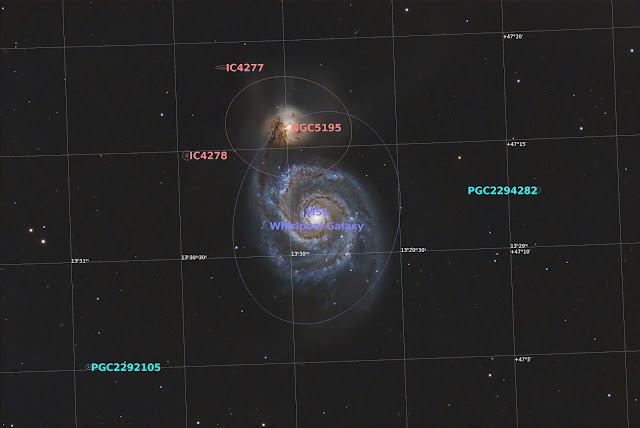Target Number Two from Friday 7/26
So picking up from where we left off in the last post (click here). After taking flats with no filter to match my B150 exposures, I installed the L-eXtreme filter and took flats. Then slewed the telescope to the Tulip Nebula (SH2-101) in Cygnus. Started collecting subs at 2:40 AM and stopped the sequence at 3:57 AM due to the increasing sky brightness and immanent loss of the target to the trees in the West. Sky conditions weren't great due to the smoke from the wildfires out west. I've settled on 180 sec as the default exposure time for imaging with the L-eXtreme. Here's the resulting image:
 |
| SH2-101, The Tulip Nebula |
Something cool in the image:
Any Rush fans out there? Any fans of Black Holes? The star labeled as HD226868 in the annotated image below is the star that orbits the black hole Cygnus X-1! See if you can see a very faint arch starting from the label HD226868 and arcing back towards +35°20’. It is really subtle, but it is the bow shock created by one of the relativistic jets emanating from the black hole interacting a denser area of dense interstellar medium. Cygnus X-1 is one of the strongest X-ray sources detectable from Earth and the first X-ray source to be widely accepted as a black hole. Cygnus X-1's status as black hole was the subject of a friendly bet between Stephen Hawking and Kip Thorne.
 |
| Crop of the annotated image of SH2-101 highlighting the star (HD226868) that orbits the black hole Cygnus X-1. |
Processing:
All pre and post processing was performed in PixInsight. Pre-Processing: All subs were visually inspected with Blink and subs with issues were removed. All light Frames, Flats, Darks and Dark flats were loaded into WBPP. Linear Post Processing: Background extraction was performed with Auto DBE Script from Seti Astro followed by BXT (correct only). SPCC was used for Color Calibration followed by a full application of BXT. Noise was reduced with NXT. The image was made non-linear with HT. Non-linear Post Processing: Stars were removed with StarXT. Stars: Saturation was increased with CT. Starless: The Narrowband normalization Process was used to get the "SHO" look. Color, intensity, and contrast were adjusted with various applications of CT. Saturation was increased with CT. LHE was applied at 3 Kernel sizes. Unsharp mask was applied and MMT was used to increase sharpness. The DSE script was used to enhance dark nebula regions. The Stars and Starless images were combined with Pixel Math to produce the final image.
What is it?
The Tulip Nebula (SH2-101) is a bright nebula in the constellation Cygnus. This region of gas and dust is an HII region. Unlike the Dark Nebula B150, the gas in the tulip is ionized and is giving off its own light.
 |
| Annotated image of SH2-101 |
How Big is it?
SH2-101 has a size of 16 x 9 arcminutes (1 degree is 60 arcminutes) on the night sky. It is about 70 light years in diameter.
How Far is it?
SH2-101 is located about 6,000 light-years (ly) from Earth in the constellation Cygnus.
How to find it?
It may be possible to view this object visually (I have never done so). I would suggest a nebula filter (like a UHC filter) to improve contrast and make the nebula "pop" in the eyepiece.
SH2-101 is located in the neck of Cygnus the Swan. About 1/2 way between the head (Albireo) and Sadr.
 |
| Finder Chart for SH2-101. |





















